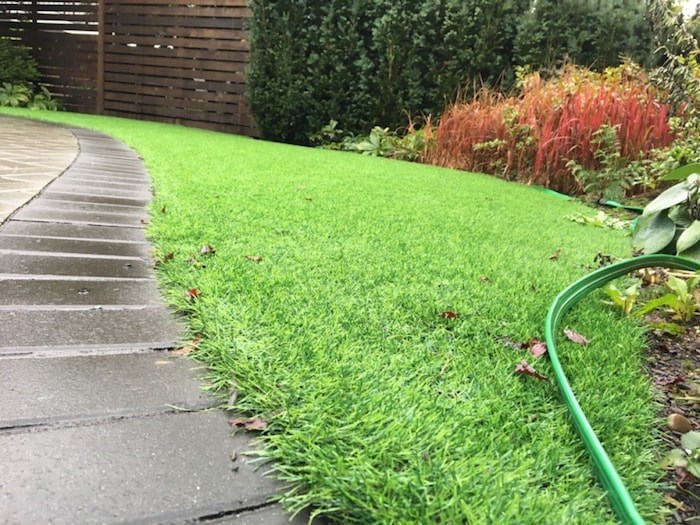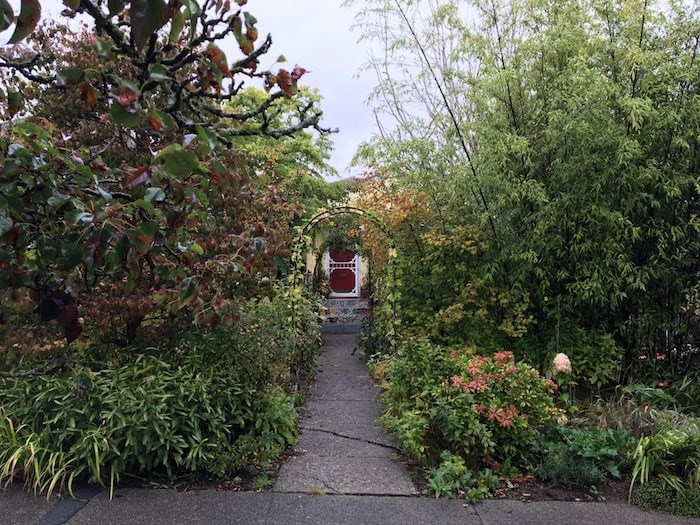If you try to keep your lawn in order in this town, chances are you’ve had a few headaches. Whether it’s European chafer beetle infestation or the drought-stricken summers that can turn your lawn from shades of Yoda to Trump in a few short weeks, maintaining any sort of quality grass habit in Vancouver can be expensive.
 Fake lawns have grown in popularity in Vancouver due to chafer beetles and scorching summers. Photo Grant Lawrence
Fake lawns have grown in popularity in Vancouver due to chafer beetles and scorching summers. Photo Grant Lawrence
My lawn managed to somehow beat out the chafer beetle, until last fall when skunks and raccoons suddenly went Animal House on it by night, while unyielding crows tore at it by day. After a harsh toke of costly maintenance, my grass grew back just in time for the first major drought of the summer.
I get it. It can be offensively First World to complain about lawn maintenance. I also realize that a lawn is a near pointless, ecologically unsound, age-old status symbol. Manicured lawns have roots to European aristocracy, which over many centuries eventually became a benchmark of pride in suburban North America. To have a lawn was to have your own private park — luxurious green space — even if it was the size of a postage stamp.
I get all that, but what I will never do is turf my headache of a lawn for a synthetic facsimile. For a few years, fake lawns became a boom industry in Vancouver — a popular alternative once both chafer beetles and scorching summers seemed like they were here to stay.
I understand the appeal. You rip out your grub-filled grass that costs you hundreds a year, and for about $12 a foot, you lay down a perfectly trim, plastic replica that forever looks like the putting green at the Shaughnessy Golf and Country Club.
But here’s my point that’s as obvious as a lawn dart landing on your foot: We live in a world infested with plastic by our own design. Our oceans, rivers and lakes are choking on it. Plastics wash up on every shoreline in the world, no matter how remote. A friend recently rowed through the Northwest Passage and was dismayed at the amount of plastic he saw, even in the Arctic Ocean. The plastics we throw away will eventually breakdown into micro plastics, potentially making their way back into our bodies through the food chain.
The last thing we should be doing is removing living plants and replacing them with more plastic. What do you think happens to synthetic lawns when they eventually wear out in about 25 years and get turfed?
The City of Vancouver agrees. According to a release dated Aug. 23, 2016, “the Planning, Urban Design and Sustainability, and Development Services, Building and Licensing departments will not approve artificial turf installations on private property.”
 Rain gardens and pollinator gardens are environmentally friendly alternatives to maintaining a lawn. Photo Grant Lawrence
Rain gardens and pollinator gardens are environmentally friendly alternatives to maintaining a lawn. Photo Grant Lawrence
The city mowed down on fake grass because of its supposed inability to allow rainwater to pass through it, which could potentially impact surrounding trees and shrubs, and create run off problems. According to a recent article on the subject from the CBC, “artificial turf does not mesh with the city's sustainability plans around rainwater, trees and biodiversity.” So far in 2018, the city has apparently ordered five private residences to remove unapproved fake grass.
But as David Suzuki has repeatedly suggested, your real lawn (and mine) is a needless water-sucker. So if the only grass you want to invest in is becoming legal on Oct. 17, and you don’t want to add to the global plastic problem, what can you do?
There are plenty of alternatives. One is a pollinator garden. You can fill your green space with wild flowers and shrubs that attract bees, butterflies, hummingbirds and other delightful creatures. Another is a rain garden — essentially letting your space go native with waist-high species such as salal and sword ferns.
If you have kids and want to keep an open, low-cut green area for play, clover is apparently the best alternative. According to the City of North Vancouver, clover lawns are “resilient, evergreen” and flower in the spring. For those without marauding children, herbs are also a possibility. Plants such as thyme, lavender and oregano are bright and colourful, you can eat them and they are highly tolerant to drought. You can go the Palm Springs route and create a rock garden with a few drought-resident plants. Or, as of this month, you crop up with a legal front yard marijuana patch.
Of course, advocates of synthetic grass say the emerald product is actually good for the environment, your wallet and your back: there’s zero watering, you’re not laying down chemical fertilizers that can potentially get washed down storm drains and no weeding.
I ain’t buying it. If you could, would you?
@grantlawrence


